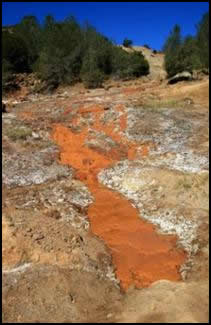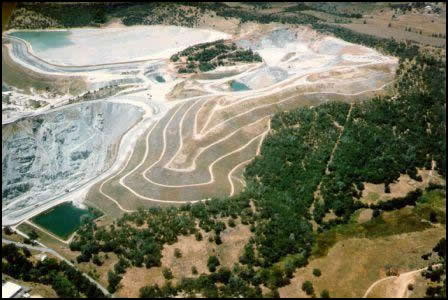Mining Program
Table of Contents
- Do I need a permit?
- Do I need to submit a Report of Waste Discharge?
- What does the Mining Program do?
- Why should I be concerned?
- Why are mines a water quality priority for the Central Valley Water Board?
- What can I do to help?
- Region 5 Success Stories
- Sulphur Creek Mining District Remediation
- Interactive Mine Map - Currently Unavailable

What does the Mining Program do?
The Mining Program oversees the discharge to land of mining waste from active and inactive mines. Much of this waste should not be discharged directly to the ground surface because of the potential threats to both surface and groundwater. Because of these threats, the mine waste in many cases must be contained to isolate them from the environment. Discharges from active mines are regulated through the issuance of waste discharge requirements and will usually regulate all of the surface impoundments, tailing ponds, and waste piles or overburden waste rock dumps. The regulations applicable to these discharges are found in California Code of Regulations Title 27 (Title 27) which apply to discharges of solid waste and designated liquid waste, used for regulation of surface impoundments, waste piles, land treatment units, and mines. These regulations have both prescriptive and performance standards for waste containment, monitoring and closure.
In-active mines (which include abandoned mines) that are threatening or impacting surface and groundwater are regulated primarily by Title 27, State Water Resources Control Board Resolution Order #92-49, and other laws and regulations for closure of mine site and cleanup. The enforcement of these laws and regulations may be voluntary or the Board may issue enforcement orders. Many sites may require long-term maintenance and the Central Valley Regional Board would regulate these mine sites through Waste Discharge Requirements. The ultimate goal of the Mining Program for inactive mines is to eliminate surface and groundwater impacts from past mining and prevent any further degradation of waters of the State.
Why should I be concerned?
Metals and salts from mining are adversely impacting rivers, streams, lakes and groundwater of the Sierra Nevada and Coast Ranges. The Sacramento and San Joaquin Delta and San Francisco Bay are impacted by discharges from mines in and surrounding the Central Valley. These discharges have adverse public health, ecological and economic impacts. For example, mercury a known carcinogen from mining in the Coast Range and from extraction of Gold in the Sierra Nevada has been found in Central Valley Rivers, lakes and estuaries, and has resulted in many health warnings throughout the Region. The sources of this mercury must be remediated as part of the solution. The Central Valley Regional Board is actively requiring remediation at both active and inactive mines. Additionally, through the 303d (identifying impaired water bodies) and the TMDL (Total Daily Maximum Load) programs mine impacts are being identified helping prioritize mine site cleanup. These mine cleanups are being coordinated with Federal and State agencies.

Why are mines a water quality priority for the Central Valley Water Board?
There are 100’s or more active or recently active mining operations and 10’s of thousands of abandoned mine features are located in the Central Valley region. Elevated levels of mercury, arsenic, copper and other metals as well as salts associated mining pose serious surface and groundwater quality concerns throughout the region. Contaminated surface water and groundwater threatens water sources used for drinking, industrial use, the environment and recreation for the entire State of California. If pollution discharges are left unchecked, this may result in limited water management options, impairment of surface water and groundwater supplies, and increased costs to municipal, industrial and agricultural water consumers.
What can I do to help?
- Report water quality issues seen in and around mining sites.
- Report water discharging from a mine adit or seeps from rock piles associated with mining.
- Conserve water usage to reduce the need to import water into the Central Valley.
- Develop strategies for reducing constituents of concern in surface water and groundwater in local plans.
- Encourage the coordination, development and implementation of cost effective advanced management technologies that involve effective water management and source control.
- Report an Environmental Concern
Contact Us
- Program Contact
George Low
(530) 224-4997
George.Low@waterboards.ca.gov - Web page problems: Webmaster5@waterboards.ca.gov
- Report an Environmental Concern
Facts and Information
- Tech Note - Mining Waste Characterization
- Water Board Mining Laws & Regulations
- Fiscal Year 23/24 Annual Report Video
(Video will open in YouTube)



